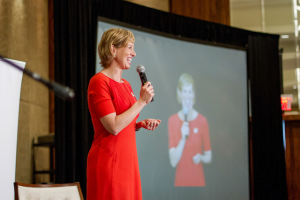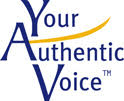 Presence is one of those things we know when we see it, without knowing how, isn’t it? When someone who has presence enters the room, or is speaking or performing, we experience it. Some call it charisma. Others the “it” factor or the “x” factor. Whatever we call it, it’s tough to define. It’s intangible. We can definitely experience it in others. Sometimes we can experience it in ourselves, although often it takes someone else to let us know about it.
Presence is one of those things we know when we see it, without knowing how, isn’t it? When someone who has presence enters the room, or is speaking or performing, we experience it. Some call it charisma. Others the “it” factor or the “x” factor. Whatever we call it, it’s tough to define. It’s intangible. We can definitely experience it in others. Sometimes we can experience it in ourselves, although often it takes someone else to let us know about it.
What is presence?
The Merriam Webster Dictionary defines presence as “the fact or condition of being present or as something present of a visible or concrete nature.” It also defines presence as “the bearing, carriage, or air of a person; especially stately or distinguished bearing; a noteworthy quality of poise and effectiveness.”
The part of that definition that stands out for me is the word, “noteworthy.” We notice someone with presence. We pay attention. We want to know or understand or connect with that person.
Presence asks us to get involved. Actually, I think presence demands we get involved. When we’re in the presence of “presence,” we’re usually involved before we even know it.
Why does presence matter?
Presence is a powerful ally in our efforts to inform, persuade, and inspire. It’s the secret sauce, and we all can have it. It’s not true that only some people have it and the rest of us are out of luck. Some may come by it naturally, yes. That doesn’t mean we can’t all join in the fun, because we can.
How do we embody it?
1. At the core of presence is emotional connection. It’s our ability to imbue what we are saying with our emotional experience. For instance, if you say “the sky is blue,” your ability to imbue that statement with how you feel about that blue sky will determine how much presence you have. Anything we say can be augmented with our emotional experience. Anything. And when we add emotional content to our presentations, we bring them to life.
2. To create an emotional connection, we need to speak to what matters. One of the first questions I ask my clients is, “What do you want for your audience?” I ask them to reflect on how their information is going to make life better for their audience, and just as importantly, why that matters to my client. I want them to connect their information to something meaningful, because only then will their audience feel it.
3. To connect with our emotions requires being present to our experience, and to our audience. We aren’t in our heads, concerned about how we’re coming across. We’re not wishing we were somewhere else. We are “in the now.” We’re fully and completely available.
I know you’ve experienced being completely present to someone. There is an intensity that isn’t there when that person is distracted. It’s palpable, and it’s magnetic. We want more of it. We want to bring this quality to our audiences. We want them to know we’re with them. When we do, we communicate we care. We communicate they are deserving of our attention, and that makes us deserving of theirs.
4. As a result of being fully present, our facial expressions, body language and other nonverbal communication signals often line up without a lot of extra effort. We can add specific emotional engagement and creative expression techniques to enhance the experience and create more drama and entertainment value. The core of the connection, though, is in being fully present, and in the authentic expression of meaning and emotion.
5. Bottom line, presence all comes down to one thing. It’s something that goes back to the Greek inscription on the Temple of Apollo at Delphi: Know thyself. To create an authentically emotional connection with our audience, and thus the presence we desire, we need to do the work to understand ourselves. Why is our message important? Why are we sharing it with this audience, at this time? What difference will it make? What difference do we want it to make?
When we do this, we experience presence and so does our audience.
I know it sounds like a lot of work if you’re just delivering the latest stats for the quarter, but even that information has meaning — often a lot of meaning for the people who are receiving it, especially if it will impact their jobs or their lives.
The good news is, when we speak with presence, it’s a whole lot more fun for everyone. And, we can have much greater impact. I would love to support you to engage your presence. I can be reached at Andrea@AndreaBeaulieu.com.
Image courtesy of Karen Stintz via flickr

Leave A Comment